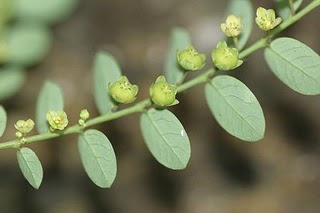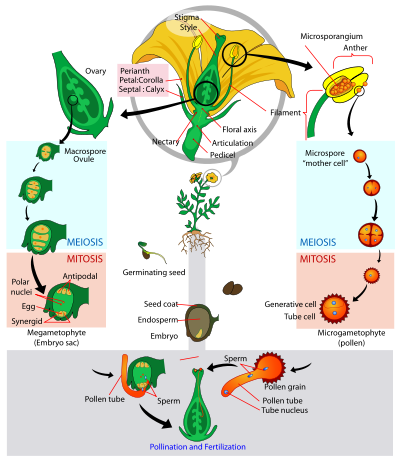Phyllanthus niruri, like most
tropical plants, has evolved several adaptations that allow it
to thrive in a tropical habitat. One of these adaptations is the shape of its leaves. Due to the
extreme rainfall in the rainforests, P. niruri needs to
be able to shed excess water. This is accomplished with what is
called a “drip tip.” The shape of the leaves are pointed in such
a way that water quickly runs off of them. It’s important for
P. niruri
to shed this over supply of water to hinder fungal and bacterial
growth.
Like all plants, P. niruri
undergoes an alternation of generations. Stonebreaker has a dominant sporophyte (diploid) stage
in its lifecycle, while the gametophyte stage (haploid) is
reduced. The flowers of Stonebreaker are monoecious meaning both
the male and female parts are on the same plant. In addition,
Phyllanthus niruri contains microspores, which are gametophytes that will
develop into pollen grains (sperm) through meiosis. It also has
megaspores that will develop into the female parts through
meiosis as well. On the anther of each flower, the
microsporangium develops microspores that get transported to the
ovule in the megasporangium either by wind pollination or
cross-pollination with insects.
After pollination, the two
gametophytes fuse together and form a diploid zygote. The zygote
develops into an embryo which is packaged inside a seed with a
food supply. When the seed finally germinates, the embry o will
undergo mitosis until P. niruri reaches adulthood.
o will
undergo mitosis until P. niruri reaches adulthood.
 o will
undergo mitosis until P. niruri reaches adulthood.
o will
undergo mitosis until P. niruri reaches adulthood.
Now that you know how Stonebreaker reproduces, let’s learn some
interesting facts.

One of the herbal plants in pharmacology is meniran. Stimuno for toddlers/children and adults there are contraindications, do not expect to be drunk by pregnant women, breastfeeding women, patients with hypersensitivity against meniran plants (Phyllanthus niruri) and patients suffering from autoimmune diseases.
ReplyDelete